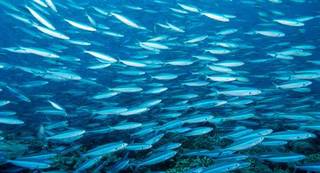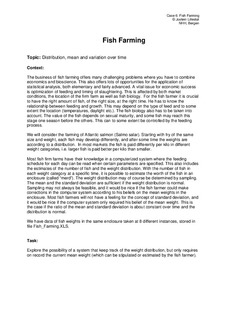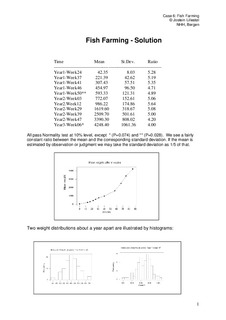| dc.description.abstract | Topic: Distribution, mean and variation over time
Context:
The business of fish farming offers many challenging problems where you have to combine economics and bioscience. This also offers lots of opportunities for the application of statistical analysis, both elementary and fairly advanced. A vital issue for economic success is optimization of feeding and timing of slaughtering. This is affected by both market conditions, the location of the firm farm as well as fish biology. For the fish farmer it is crucial to have the right amount of fish, of the right size, at the right time. He has to know the relationship between feeding and growth. This may depend on the type of feed and to some extent the location (temperatures, daylight etc.). The fish biology also has to be taken into account. The value of the fish depends on sexual maturity, and some fish may reach this stage one season before the others. This can to some extent be controlled by the feeding process.
We will consider the farming of Atlantic salmon (Salmo salar). Starting with fry of the same size and weight, each fish may develop differently, and after some time the weights are according to a distribution. In most markets the fish is paid differently per kilo in different weight categories, i.e. larger fish is paid better per kilo than smaller.
Most fish firm farms have their knowledge in a computerized system where the feeding schedule for each day can be read when certain parameters are specified. This also includes the estimates of the number of fish and the weight distribution. With the number of fish in each weight category at a specific time, it is possible to estimate the worth of the fish in an enclosure (called “merd”). The weight distribution may of course be determined by sampling. The mean and the standard deviation are sufficient if the weight distribution is normal. Sampling may not always be feasible, and it would be nice if the fish farmer could make corrections in the computer system according to his beliefs on the mean weights in the enclosure. Most fish farmers will not have a feeling for the concept of standard deviation, and it would be nice if the computer system only required his belief of the mean weight. This is the case if the ratio of the mean and standard deviation is about constant over time and the distribution is normal.
We have data of fish weights in the same enclosure taken at 8 different instances, stored in file Fish_Farming.XLS.
Task:
Explore the possibility of a system that keep track of the weight distribution, but only requires on record the current mean weight (which can be stipulated or estimated by the fish farmer). | nb_NO |


